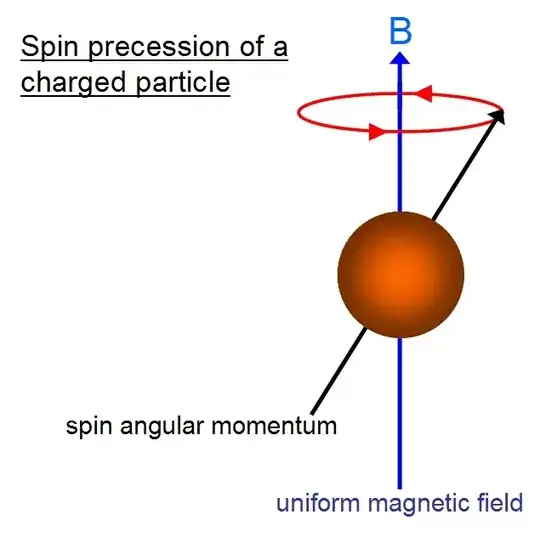How does the electrons' magnetic dipole moment get influenced when electrons are moving through a magnetic field? How does the electrons' intrinsic spin influence the direction of the electrons' movement during the alignment of the dipole moment to the external magnetic field?
1 Answers
How the electron's magnetic dipole moment gets influenced when electrons are moving through a magnetic field?
In a classical context, the dipole moment of a fundamental particle is fixed: it doesn't change when in an electromagnetic field. If Nature were classical, the dipole moment of electrons would be $\boldsymbol\mu=2\mu_B\boldsymbol S$, where $\mu_B$ is the Bohr magneton ($\mu_B=5.8\ 10^{-5}\ \mathrm{eV/T}$) and $\boldsymbol S$ is the intrinsic spin of the electron (whatever that means: in a classical context, spin is not well defined. Spin is an intrinsically quantum phenomenon). If you place this electron in a magnetic field, it will feel a torque, but the value of $\boldsymbol \mu$ won't change.
In QM, there is always a magnetic field (in a certain sense). You cannot isolate fundamental particles from interactions with the electromagnetic field. This in turns changes the value of the dipole moments in a well-defined way (through radiative corrections). These changes are usually very small: for example, in the case of electrons, the formula above changes into $\boldsymbol \mu=2.0023\mu_B\boldsymbol S$. Photons are responsible for this small change.
How the electron's intrinsic spin agitate on the direction of the electrons movement during the alignment of the dipole moment to the external magnetic field?
Let $\boldsymbol \mu$ be the dipole moment of a particle, and $\boldsymbol S$ its spin. In general we can write $$ \boldsymbol\mu=g\mu_B\boldsymbol S $$ where $\mu_B$ is the Bohr magneton, and $g$ is the $g$-factor. According to Newton's Second Law, $\dot{\boldsymbol S}=\boldsymbol\mu\times \boldsymbol B$, from which we find $$ \dot{\boldsymbol S}=g\mu_B \boldsymbol S\times\boldsymbol B $$ whose solution is a precession of $\boldsymbol S$ around $\boldsymbol B$: $$ \begin{aligned} \boldsymbol S_\parallel(t)&=\boldsymbol S_\parallel(0)\\ \boldsymbol S_\perp(t)&=\boldsymbol S_\perp(0)\ \mathrm e^{-i\omega_s t}\\ \end{aligned} $$ where $\omega_s=g\mu_BB$
 (borrowed from http://cronodon.com/Atomic/quantum_angular_momentum.html)
(borrowed from http://cronodon.com/Atomic/quantum_angular_momentum.html)
For completeness, we should point out that if the magnetic field is inhomogeneous ($\boldsymbol B=\boldsymbol B(\boldsymbol r)$) then the dipole will also feel a transaltional force. The easiest way to see this is that the potential energy of a dipole is $W=-\boldsymbol \mu\cdot\boldsymbol B$, so that $$ \boldsymbol F=-\nabla W=\nabla(\boldsymbol\mu\cdot\boldsymbol B)\neq 0 $$
Only in the case of constant magnetic field $\nabla\boldsymbol B=0$, and we only get rotational motion. If $\boldsymbol B$ is inhomogeneous, there is also a translational force.
- 53,248
- 20
- 131
- 253
-
Since the electron is moving how the trajectory of the electron is influenced by an (non-parallel to the movement) external magnetic field due to the change in the spins directions? Could you please extend your answer? – HolgerFiedler Mar 19 '16 at 19:58
-
@HolgerFiedler actually, that is already addressed in my post (see last set of equations): the part of the spin that is parallel to the magnetic field ($\boldsymbol S_\parallel$) is constant in time (it doesnt change), while the orthogonal part ($\boldsymbol S_\perp$) precesses around the magnetic field. In general, the spin won't be parallel to the field, but you just have to project the two components (parallel and perpendicular). Each of these components independently evolve in time. – AccidentalFourierTransform Mar 19 '16 at 20:02
-
I like your answer. But for fullness of the answer it would be nice to see explicitly the point of the translational force from dmckees answer. – HolgerFiedler Mar 19 '16 at 20:17
-
-
Even in an uniform magnetic field moving (non-parallel to the field) charges as well as neutrons get deflected. Explanation see this 5 times down voted answer – HolgerFiedler Mar 20 '16 at 13:55
quantum-spin(for intrinsic spin) anddipole-moment(for magnetic dipole moment). These are synonyms. Also,magnetic-inductionhas barely nothing to do here. If you disagree with the edits, you can revert them by clicking on theeditbutton. – AccidentalFourierTransform Mar 19 '16 at 19:26